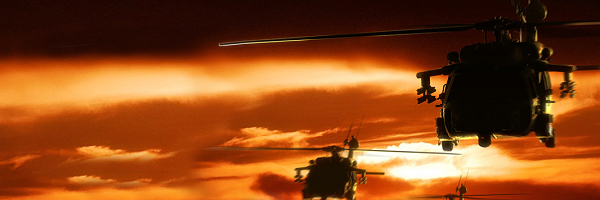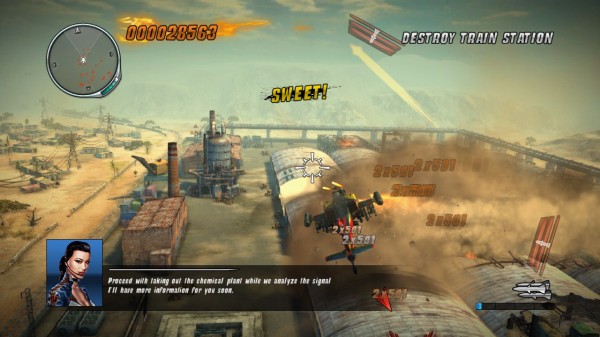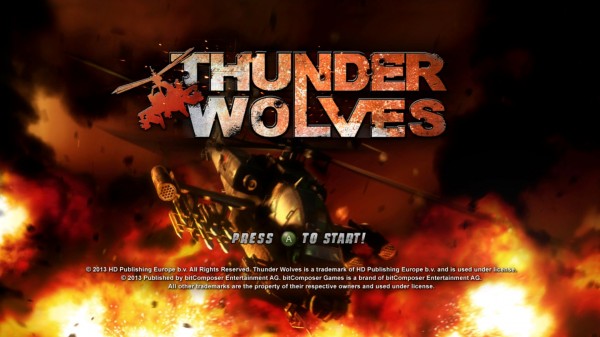
Thunder Wolves PC Review
This may sound like a stereotypical male, but man, I love explosions. Thankfully, loving explosions won’t get me into trouble in a virtual world. If there was one period that promoted the enjoyment of explosions, it was most likely the 80s. We’ve had a bit of a resurgence with explosive action flicks, with the likes of The Expendables, The A-Team and Predators all tapping into peoples’ enjoyment of such over-the-top action. The developers at Most Wanted Entertainment seem to be such fans of action and booms, as Thunder Wolves, which sounds like a title ripped straight from the 8-bit era (I can’t believe a game didn’t exist with this name back then), is nothing but the mayhem of raining down volleys of missiles, rockets and machine gun fire from a helicopter and laughing at the sight of the flames of destruction created to satisfy your pyromaniac tendencies.
Story is definitely not the game’s strongest point, but it was never intended to be. Thunder Wolves’ plot is a throwback to those 80s action cartoons, films and even mid-90s arcade video games that crafted a basic story – usually terrible, yet amusing – that would allow for the inclusion of guns and explosions. The game takes place in two time periods: the game’s current time of 1991 and a flashback that goes to 1986, building up a tale of relationships between members of the team. The start of the game throws you in as a rookie pilot named Blister, who has joined the band of renegade mercenaries known as Team Wolf One. This gang of military A-Team stereotypes has a sole purpose to fight against a terrorist group led by a villain named Serpent… That’s some G.I Joe naming convention if I ever heard one. Characters have no real depth to their personality, instead mostly just throwing out a few lines, a one-liner or two and an F-bomb for laughs when the action gets going. Hell, the game’s even got the heavy metal rifts to go with the whole 80s setting.

I had seen limited footage of Thunder Wolves before playing it, and I got a sense that it was similar to EA’s old classic helicopter (Desert/Jungle/Urban) Strike franchise, but that really isn’t the case. While some elements do cross over – controlling a helicopter, occasionally boarding a tank, and using a tow rope to pick up civilians – it’s not the same style of game. For starters, Thunder Wolves is much more linear than any of the open-ended level structure that was part of the Strike series. Thunder Wolves is also faster-paced, leaving behind any sort of simulation features of a helicopter game and going down the route of fast, arcade action. The camera is also from behind the helicopter, rather than top-down, giving a sense of a third-person shooter in a helicopter. There’s even an over-the-shoulder aim mode that will zoom-in closer to the helicopter when you want to make it easier to target objects.
Controls for such an arcade game need to be responsive. Originally I was playing the game using the Xbox 360 controller, which was fine to use after adjusting, but it wasn’t my preferred method because some of the button layouts were in strange positions. One such is the use of pressing down on the Left Stick and Right Stick to lower and raise the altitude of the helicopter. It wasn’t very helpful when in the midst of a gunfight with other airborne vehicles. Thankfully, the mouse and keyboard are much easier for controls, with the typical WASD controlling your chopper and the keys close to them used to elevate the height. The mouse is used for aiming and shooting the primary and secondary weapons. Additionally, these helicopters are extremely agile, with a nitro button used in conjunction with the movement to boost, either to arrive faster at a target location or to strafe past gunfire and heat-seeking rockets. Flares can also be used to dodge such hostile weapons. There’s a lot here to help the player keep alive, and the game keeps the action going for most of the time – to the point that it feels you’re always pressing buttons. All of this is going on while the game throws “Hella sick!” in your face, as if to signal you have just completed some crazy Tony Hawk: Pro Skater combination trick. It’s comical.

They are around nine choppers in total, each armed with statistics based on movement, armour and agility, along with weaponry that includes a mini-gun and three secondary armaments. You cannot change these, as weapons are locked to their selected helicopter, giving more reasons to pick the right one for you. Typically, you’ll have a varied amount of rockets and homing rockets, then one big bomb, such as an airstrike summon or a cluster missile, which will destroy an area of enemies. Players technically have unlimited ammo for the secondary weaponry, but these cannot be abused, as they deplete and refill over time. Small boxes will glow blue when they are usable, giving the option to use a barrage of missiles or fire them tactically to keep a supply in stock that is ready to be used when needed, which, to be honest, is all the time.
Even though for the most part all you are doing is blasting objects to smithereens, the 13 missions available do have some variety to them. On one mission, you are protecting civilians on an oil rig from an assault; on another, you’re refuelling your helicopter and preparing an attack on a large battleship. The developers will normally throw in a mini-game for each level. The main one is where the camera switches from third-person to first-person, with the game transitioning to an on-rails shooter. Occurring less often are the sniper situations, which are mundane and require little precision. As long as you aim somewhat close to the enemy, they will die from the sniper shot. These sections are often short and easy, and, while not as fun as the main game’s mechanics, are a nice inclusion to mix up the destructive gameplay with a different perspective.

Even with the mission design and switch-up of the gameplay, you’re still doing one thing: shooting, and shooting some more. There isn’t much to stop that feeling of repetition creeping in, which I guess is why the game is extremely short – around three hours, depending how many times you die. The mechanics of the game aren’t exactly something I would call deep, and after finishing it there isn’t anything to bring you back. Cooperative play is implemented, but it is local only and it’s not what you think. Instead of two helicopters, it’s one – one player pilots the machine and the other acts as the gunner. I’m sure some people will get a kick out of that design, but I personally would have loved to have the two choppers causing mass destruction together. Leaderboards are implemented, but the scoring system along with the simple combat mechanics aren’t strong enough to make it feel worthwhile to attempt to bother with thrashing anyone’s best scores.
I’m not sure if the graphics were designed intentionally the way they are, but the game has a budget appeal. I don’t mean that as a negative, as this actually works in its favour and brings in the vibe of the mid-90s, when arcade games were 3D but lacked detail and fancy menu designs. Just look at the title screen – it screams old-school. Relating to Thunder Wolves, this covers areas such as the extremely low polygon soldiers (which are fully on display in the sniper missions) and tank tracks that don’t move when the tank is moving. Like I said, it doesn’t harm the game, but some people might be picky about specifics such as this. Fans of games with a destructive nature will be happy to know that near enough all the buildings can be blown up. Regarding sounds and music, the voice acting is actually good and conveys the characters jokey attitudes well. Music, on the other hand, is a different story. Songs start out well with fitting metal rifts, but there seems to be a limited amount of songs. It isn’t long till they begin replaying the same tunes again, to the point that songs blend together as one.

A game like Thunder Wolves is aimed at doing one thing in mind, offering players the chance to blow crap up, and it knows it. If you identify with that, then there are aspects of Thunder Wolves that are pleasing for those who aren’t looking for a complex time and just want to cause a mess. Unlike all those memorable classic 80s flicks, though, Thunder Wolves is a game that doesn’t have enough charm to be a worthwhile return and will be forgotten from memory in the near future. It’s the summer blockbuster movie of the arcade-shooter world, then – a short but mildly enjoyable piece of entertainment, and that’s not necessarily a bad thing to be.
